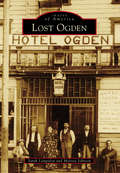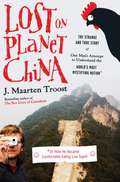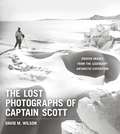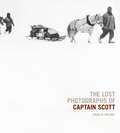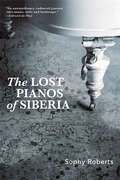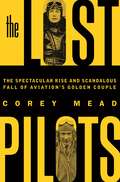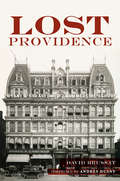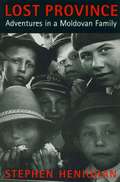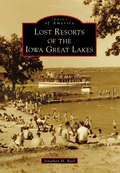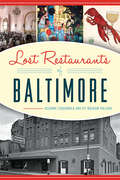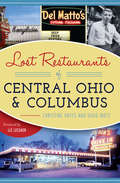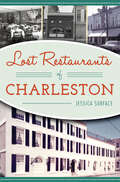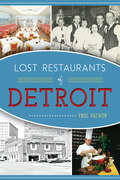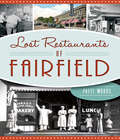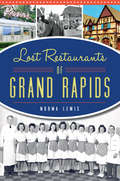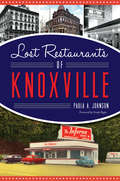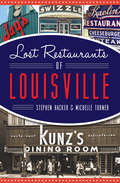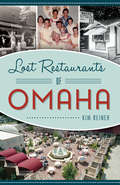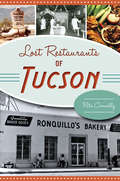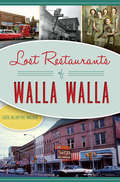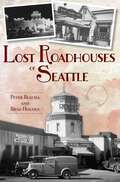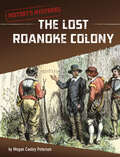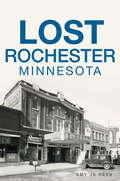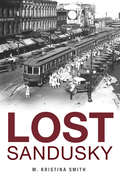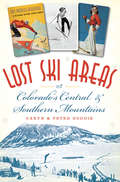- Table View
- List View
Lost Ogden
by Sarah Langsdon Melissa JohnsonFrom a fur-trapping fort to a thriving metropolitan community, change has always been a part of Ogden's history. Settled in 1850 by Mormon pioneers, Ogden was forever transformed by the arrival of the transcontinental railroad in 1869. As horse-drawn carriages gave way to motor cars, a busy downtown district grew up around Ogden's Union Station and notorious Twenty-fifth Street. Landmark businesses, such as J.G. Read & Brothers Company and the Broom Hotel, became a part of the city's unique identity. Also unique to the city were its celebrations and special events, like parades, musicals, and sporting competitions. While change has always come to Ogden, the memories remain.
Lost on Planet China: The Strange and True Story of One Man's Attempt to Understand the World's Most Mystifying Nation or How He Became Comfortable Eating Live Squid
by J. Maarten TroostThe bestselling author of The Sex Lives of Cannibals returns with a sharply observed, hilarious account of his adventures in China--a complex, fascinating country with enough dangers and delicacies to keep him, and readers, endlessly entertained. Maarten Troost has charmed legions of readers with his laugh-out-loud tales of wandering the remote islands of the South Pacific. When the travel bug hit again, he decided to go big-time, taking on the world's most populous and intriguing nation. In Lost on Planet China, Troost escorts readers on a rollicking journey through the new beating heart of the modern world, from the megalopolises of Beijing and Shanghai to the Gobi Desert and the hinterlands of Tibet. Lost on Planet China finds Troost dodging deadly drivers in Shanghai; eating Yak in Tibet; deciphering restaurant menus (offering local favorites such as Cattle Penis with Garlic); visiting with Chairman Mao (still dead, very orange); and hiking (with 80,000 other people) up Tai Shan, China's most revered mountain. But in addition to his trademark gonzo adventures, the book also delivers a telling look at a vast and complex country on the brink of transformation that will soon shape the way we all work, live, and think. As Troost shows, while we may be familiar with Yao Ming or dim sum or the cheap, plastic products that line the shelves of every store, the real China remains a world--indeed, a planet--unto itself. Maarten Troost brings China to life as you've never seen it before, and his insightful, rip-roaringly funny narrative proves that once again he is one of the most entertaining and insightful armchair travel companions around.
The Lost Photographs of Captain Scott: Unseen Images from the Legendary Antarctic Expedition
by David M. WilsonThe myth of Scott of the Antarctic, Captain Robert Falcon Scott, icon of fortitude and courage who perished with his fellow explorers on their return from the South Pole on March 29th, 1912, is an enduring one, elevated, dismantled and restored during the turbulence of the succeeding century. Until now, the legend of the doomed Terra Nova expedition has been constructed out of Scott's own diaries and those of his companions, the sketches of 'Uncle Bill' Wilson and the celebrated photographs of Herbert Ponting. Yet for the final, fateful months of their journey, the systematic imaging of this extraordinary scientific endeavor was left to Scott himself, trained by Ponting. In the face of extreme climactic conditions and technical challenges at the dawn of photography, Scott achieved an iconic series of images; breathtaking polar panoramas, geographical and geological formations, and action photographs of the explorers and their animals, remarkable for their technical mastery as well as for their poignancy. Lost, fought over, neglected and finally resurrected, Scott's final photographs are here collected, accurately attributed and catalogued for the first time: a new dimension to the last great expedition of the Heroic Age and a humbling testament to the men whose graves still lie unmarked in the vastness of the Great Alone.
The Lost Photographs Of Captain Scott: Unseen Images From The Legendary Antarctic Expedition
by Dr. David M. WilsonCaptain Scott perished with four of his fellow explorers on their return from the South Pole in March 1912. Almost immediately the myth was founded, based on Scott's diaries, turning him into an icon of courage in the face of impossible circumstances. But during the final months of that journey Scott also took a series of breathtaking photographs: panoramas of the continent, superb depictions of mountains and formations of ice and snow, and photographs of the explorers on the polar trail. But these photos have never been seen - initially fought over, neglected, then lost - until now, that is. For the first time, they are resurrected and are a humbling testament to the men whose graves still lie unmarked in the vastness of the Great Alone.
The Lost Pianos of Siberia: A Far-flung Search For Russia's Remarkable Survivors
by Sophy RobertsThis “melodious” mix of music, history, and travelogue “reveals a story inextricably linked to the drama of Russia itself . . . These pages sing like a symphony.” —The Wall Street JournalSiberia’s story is traditionally one of exiles, penal colonies, and unmarked graves. Yet there is another tale to tell. Dotted throughout this remote land are pianos—grand instruments created during the boom years of the nineteenth century, as well as humble Soviet-made uprights that found their way into equally modest homes. They tell the story of how, ever since entering Russian culture under the westernizing influence of Catherine the Great, piano music has run through the country like blood.How these pianos traveled into this snowbound wilderness in the first place is testament to noble acts of fortitude by governors, adventurers, and exiles. Siberian pianos have accomplished extraordinary feats, from the instrument that Maria Volkonsky, wife of an exiled Decembrist revolutionary, used to spread music east of the Urals, to those that brought reprieve to the Soviet Gulag. That these instruments might still exist in such a hostile landscape is remarkable. That they are still capable of making music in far-flung villages is nothing less than a miracle.The Lost Pianos of Siberia follows Roberts on a three-year adventure as she tracks a number of instruments to find one whose history is definitively Siberian. Her journey reveals a desolate land inhabited by wild tigers and deeply shaped by its dark history, yet one that is also profoundly beautiful—and peppered with pianos.“An elegant and nuanced journey through literature, through history, through music, murder and incarceration and revolution, through snow and ice and remoteness, to discover the human face of Siberia. I loved this book.” —Paul Theroux
The Lost Pilots: The Spectacular Rise and Scandalous Fall of Aviation's Golden Couple
by Corey MeadCorey Mead's The Lost Pilots is the saga of two star crossed pilots who soar to the greatest heights of fame, tailspin into scandal and crime, and go the ultimate lengths for a chance at redemption...During the height of the roaring twenties, Jessie Miller longs for adventure. Fleeing a passionless marriage in the backwaters of Australia, twenty-three-year-old Jessie arrives in London and promptly falls in with the Bright Young Things, those gin-soaked boho-chic intellectuals draped in suits, flapper dresses, and pearls. At a party Jessie meets Captain William Lancaster, married himself and fresh from the Royal Air Force, with a scheme in his head to become as famous as Charles Lindbergh, who has just crossed the Atlantic. Lancaster will do Lindy one better: fly from London to Melbourne, and in Jessie Miller he’s found the perfect co-pilot.Within months the two embark on a half-year journey across the globe, hopping from one colonial outpost to the next. But like world records, marriage vows can be broken, and upon their landing in Melbourne Jessie and William are not only international celebrities, but also deeply inlove.Yet the crash of 1929 catches up to even the fastest aviator, and the couple finds themselves in dire straits at their rented house on the outskirts of Miami – the bright glare of the limelight fading quickly.To make ends meet Jessie agrees to write a memoir, and picks the dashing Haden Clarke to be her ghostwriter. It’s not long before this toxic mix of bootleg booze and a handsome interloper leads to a shocking crime, a trial that rivets and scandalizes the world, and a reckless act of abandon to win back former glory.The Lost Pilots is an extraordinary true story, brought to vivid life by Corey Mead. Based on years of research, and full of adventure, forbidden passion, crime, scandal and tragedy, it is a masterwork of narrative nonfiction that firmly restores one of aviation’s leading female pioneers to her rightful place in history.
Lost Providence (Lost)
by Andres Duany David BrussatProvidence has one of the nation�s most intact historic downtowns and is one of America�s most beautiful cities. The history of architectural change in the city is one of lost buildings, urban renewal plans and challenges to preservation. The Narragansett Hotel, a lost city icon, hosted many famous guests and was demolished in 1960. The American classical renaissance expressed itself in the Providence National Bank, tragically demolished in 2005. Urban renewal plans such as the Downtown Providence plan and the College Hill plan threatened the city in the mid-twentieth century. Providence eventually embraced its heritage through plans like the River Relocation Project that revitalized the city�s waterfront and the Downcity Plan that revitalized its downtown. Author David Brussat chronicles the trials and triumphs of Providence�s urban development.
Lost Province: Adventures in a Moldovan Family
by Stephen HenighanStephen Henighan, a Romanian grammar book and hours of language tapes under his belt, billets with a family as an English teacher in Moldova, a country born from the dismantling of Romania during World War II. <P><P>As a Westerner in this "lost province" and former Soviet republic, Henighan feels he’s an unnerving disappointment for many Moldovans, especially to the MTV-addicted, twenty-year-old Andrei.
Lost Resorts of the Iowa Great Lakes (Images of America)
by Jonathan ReedSince the first rustic vacation retreat for hunters and fishermen was built in 1871, Okoboji and the Iowa Great Lakes have been a drawing card for families, generation after generation. Over the decades, dozens of vacation resorts, from the magnificent Hotel Orleans on Big Spirit Lake to the iconic Inn on West Okoboji, have lured happy summertime visitors. Just mentioning the name of a resort often evokes memories of swimming, boating, fishing, waterskiing, or just good times spent with friends and family. However, most of these vacation resorts are now gone--The Inn, Manhattan Beach Hotel, Templar Park, and Crandall's Lodge have all been demolished. Vacation Village has become Village West, and the Crescent Beach resort, which at one time boasted over 100 apartments or cottages, now has fewer than 30 motel-style units. Gone too are dozens of friendly mom-and-pop cottage resorts all around the lakes, replaced by condominiums and private residences.
Lost Restaurants of Baltimore (American Palate)
by Suzanne Loudermilk Kim Watson PollardBaltimore's unforgettable dining scene of the past is re-visited here in thirty-five now shuttered restaurants that made their mark on this city.Haussner's artwork. Coffey salad at the Pimlico Hotel. Finger bowls at Hutzler's Colonial Tea Room. The bell outside the door at Martick's Restaurant Francais. Details like these made Baltimore's dining scene so unforgettable. Explore the stories behind thirty-five shuttered restaurants that Baltimoreans once loved and remember the meals, the crowds, the owners and the spaces that made these places hot spots. Suzanne Loudermilk and Kit Waskom Pollard share behind-the-scenes tales of what made them tick, why they closed their doors and how they helped make Baltimore a culinary destination.
Lost Restaurants of Central Ohio and Columbus (American Palate)
by Christine Hayes Doug Motz Liz LessnerFrom remote diners to downtown political havens, the restaurants of central Ohio satisfied palates for generations. In the era of Sunday drives before interstates, fabulous family-owned restaurants were the highlight of the trip. Sample the epicurean empires established by Greek, Italian, German and Chinese families. Recall the secrets of Surly Girl's chandelier, the delicious recipes handed down by chefs and the location of Flippo the Clown's former jazz hideaway. Following their previous book, Lost Restaurants of Columbus, authors Christine Hayes and Doug Motz deliver a second helping of unforgettable establishments that cemented central Ohio's reputation for good food and fun. That includes eighteen destination eateries in fifteen surrounding towns.
Lost Restaurants of Charleston (American Palate)
by Jessica SurfaceDiscover the culinary heritage of South Carolina&’s famous port city with this guide to historic restaurants that have come and gone. Once a sleepy city of taverns and coffeehouses, Charleston evolved into a culinary powerhouse of innovative chefs and restaurateurs. Jessica Surface, founder of Chow Down Charleston Food Tours, celebrates the city&’s rich cultural history in Lost Restaurants of Charleston. The origins of she-crab soup trace back through Everett&’s Restaurant. The fine dining of Henry&’s evolved from a Prohibition-era speakeasy. Desserts were flambéed from the pulpit of a deconsecrated church at Chapel Market Place, and Robert&’s hosted Charleston&’s famous singing chef. From blind tigers to James Beard Awards, Surface explores the stories and sites that give Charleston its unique flavor.
Lost Restaurants of Detroit (American Palate)
by Paul VachonThrough stories and recipes nearly lost to time, author Paul Vachon explores the history of the Motor City's fine dining, ethnic eateries and everything in between. Grab a cup of coffee - he's got stories to share.While some restaurants come and go with little fanfare, others are dearly missed and never forgotten. In 1962, patrons of the Caucus Club were among the first to hear the voice of an eighteen-year-old Barbra Streisand. Before Stouffer's launched a frozen food empire, it was better known for its restaurants with two popular locations in Detroit. The Machus Red Fox was the last place former Teamsters president Jimmy Hoffa was seen alive.
Lost Restaurants of Fairfield (American Palate)
by Patti WoodsThe culinary history of Fairfield, Connecticut, brims with bygone and beloved eateries and watering holes. Discover some of these lost classics, from the Sun Tavern--where George Washington enjoyed a few victuals--to the Scenario, where local celebrities always had a seat reserved at the bar. The best doughnuts in town were at the corner of Post and Beaumont at Devore's, while Art Green served up his famous chocolate cream pies at the Pie Plate. Join author Patti Woods for a generous serving of nostalgia complete with nachos from Sidetrack's, chili from Kuhn's and maybe even an ice cold beer from the Driftwood.
Lost Restaurants of Grand Rapids (American Palate)
by Norma LewisGrand Rapids restaurants have served up meals and memories since the city's earliest days. At Bentham's, one of the first downtown restaurants, customers without money to eat could trade an animal pelt for supper. John Sebaitis trained his German shepherd, Spooky, to serve beer to the patrons at his tavern. And a seventeen-year-old Gerald R. Ford worked part time as a server and dish washer at Bill's Place. Join Norma Lewis as she explores the history of Grand Rapids' most beloved eateries and the stories behind them.
Lost Restaurants of Knoxville (American Palate)
by Paula A. JohnsonOver the past 225 years, Knoxville dining has come full circle—from early taverns and saloons to upscale continental cuisine and back to the roots of local eating experiences. Greek immigrants Frank and George Regas founded the legendary Regas Restaurant, which operated for 90 years, spreading culinary influence throughout the entire city. Early country music stars frequented Harold’s Deli while visiting the city to perform on Tennessee’s first live radio shows. Guests from around the world sat 266 feet in the air at the Sunsphere Restaurant, a fine dining establishment run by the Hardee’s Corporation during Knoxville’s World’s Fair. Discover these and many more fascinating stories as author and historian Paula Johnson dives back in time through the stories of the city’s great restaurants.
Lost Restaurants of Louisville (American Palate Ser.)
by Stephen Hacker Michelle TurnerLouisville was home to fine cuisine long before the famous restaurant rows on Bardstown Road, Frankfort Avenue and East Market Street. Mazzoni's served the area's first rolled oyster. At the C-54 Grill, guests dined inside a remodeled aircraft, and Kaelin's prepared its classic cheeseburger. Hasenour's sauerbraten and Hoe Kow's war sui gai are two dishes that still make local mouths water when mentioned. Authors Stephen Hacker and Michelle Turner revisit the vivid personalities, celebrated spaces and unique recipes that made Louisville's historic eateries unforgettable.
Lost Restaurants of Omaha (American Palate)
by Kim ReinerOmaha is known for its beef, but the history of its most famous restaurants goes far beyond. The French Café was the place to go to celebrate. Piccolo Pete's, Mister C's and Bohemian Café helped shape neighborhoods in Little Italy, North Omaha and Little Bohemia. The tales of restaurateurs like the tragic Tolf Hanson; the ever-optimistic Ross Lorello; Anthony Oddo, once a resident at Boys Town; and Giuseppa Marcuzzo, a former bootlegger, also tell the story of the city. Restaurants played a prominent role as history unfolded in Omaha during prohibition, wartime rations, the fight for equal rights and westward expansion. Author Kim Reiner details the fascinating history behind Omaha's classic eateries.
Lost Restaurants of Tucson (American Palate)
by Rita ConnellyFrom western roadhouses to fine dining, Tucson boasts an extraordinary lineup of diverse restaurants. Though some of its greatest no longer exist, their stories conjure the sights, smells and sounds of the city's history. Longtime locals still buzz about Gordo's famous chimichangas, an accidental dish originating in Tucson. The legendary Tack Room was a beacon of fine dining. Places like Café Terra Cotta and Fuego pioneered a new southwestern cuisine, serving regional dishes like prickly pear pork and stuffed poblanos. University of Arizona alumni miss old spots like the Varsity, while long-gone haunts like Gus & Andy's attracted a unique crowd of businessmen, movie stars and the occasional mobster. Join local food writer Rita Connelly as she serves up savory stories of good food and good company from the gone but never forgotten favorites of the Old Pueblo.
Lost Restaurants of Walla Walla (American Palate)
by Catie McIntyre WalkerDining in Walla Walla blossomed from an influx of mining transplants in the late 1800s. Within decades, a roadhouse called the Oasis boasted a seventy-two-ounce slab of beef, and the old Pastime Café opened at 5:30 a.m. with white toast and whiskey for breakfast. In the early 1950s, Ysidro Berrones opened one of the valley's first Mexican restaurants, the El Sombrero Tortilla Factory and Café. Owner of Denney's Hi-Spot for two decades, Joe Denney also satisfied locals with his morning crooning to piano on KTEL. Native and local wine writer Catie McIntyre Walker celebrates this rich heritage with decades of departed, beloved establishments and the people behind them.
Lost Roadhouses of Seattle (American Palate)
by Peter Blecha Brad HoldenProhibition came early to Washington State--in 1916--and kicked off an unforgettable era of nightlife.Prohibition went national in 1920 and a network of roadside inns, taverns and dancehalls just outside of Seattle's city limits thrived well into the rockin' 1950s, providing illicit entertainment for those seeking a good time. Spurred on by early car culture and strict liquor laws, places like the Spanish Castle, The Jungle and The Black Cat sprang into being. Commonly called roadhouses, many of these remote outposts existed along two newly-built and parallel stretches of county highways - far from the prying eyes of city police. Fabled speakeasy operator, "Doc" Hamilton founded some of the earliest of these hideaways.Join authors Peter Blecha and Brad Holden as they uncover the fascinating era of forbidden nightclubs.
The Lost Roanoke Colony (History's Mysteries)
by Megan Cooley PetersonIn 1587, a group of about 115 English settlers arrived on Roanoke Island near North Carolina. They were there to establish an English colony. Later that year, the colony’s leader left the island to get supplies. His return trip was delayed. When he finally returned in 1590, the colony and its settlers were gone. What happened to the settlers? Explore the theories behind their disappearance and why it has become one of history’s greatest mysteries.
Lost Rochester, Minnesota (Lost)
by Amy Jo HahnRochester is synonymous with one of its most famous landmarks, the Mayo Clinic, but there's so much more to the Med City. It began as a frontier town, struggling to make its mark in a sparsely populated wilderness. By the late nineteenth century, Rochester had expanded into a vibrant city, rich with business, educational and cultural opportunities. Rediscover the Dubuque Trail and the beautiful summer lake retreats, along with the Cook Hotel, the Central Fire Station and more. Author Amy Jo Hahn uncovers the lost beginnings of Rochester and brings the stories of this unique place to life.
Lost Sandusky (Lost)
by M. Kristina SmithSANDUSKY BUILT ITS REPUTATION on the appeal of a picturesque lakefront and the opportunities of a manufacturing hub. Not only did its factories keep pace with the transportation industry, but the Ohio city also boasted the headquarters of international paper maker Hinde and Dauch and enough crayon production to be called the "Color Capital of the World." The amusement park at Cedar Point helped launch a new form of entertainment that continues today. But while the town remains a vacation destination and retains some heavy industry, it misses much of its former glory. Join M. Kristina Smith in revisiting those landmarks of Sandusky's past.
Lost Ski Areas of Colorado's Central and Southern Mountains
by Peter Boddie Caryn BoddieColorado's central and southern mountains still draw droves of skiers to the slopes. However, many of the historic runs and areas that were popular over the past century--some near the current resorts of Aspen, Breckenridge, Crested Butte, Purgatory, Telluride and Vail--no longer exist. Local hills like Whittaker Ranch near Eagle featured little more than a rope tow and warming hut. Now underneath Lake Dillon, Prestrud Jump hosted tournaments where Olympian Anders Haugen broke ski-jumping world records. From Lands End near Grand Junction to Sugarite near Trinidad, from swanky Hoosier Pass in Summit County to Stoner in Montezuma County, authors Caryn and Peter Boddie take readers on a tour of the lost ski areas of central and southern Colorado.
